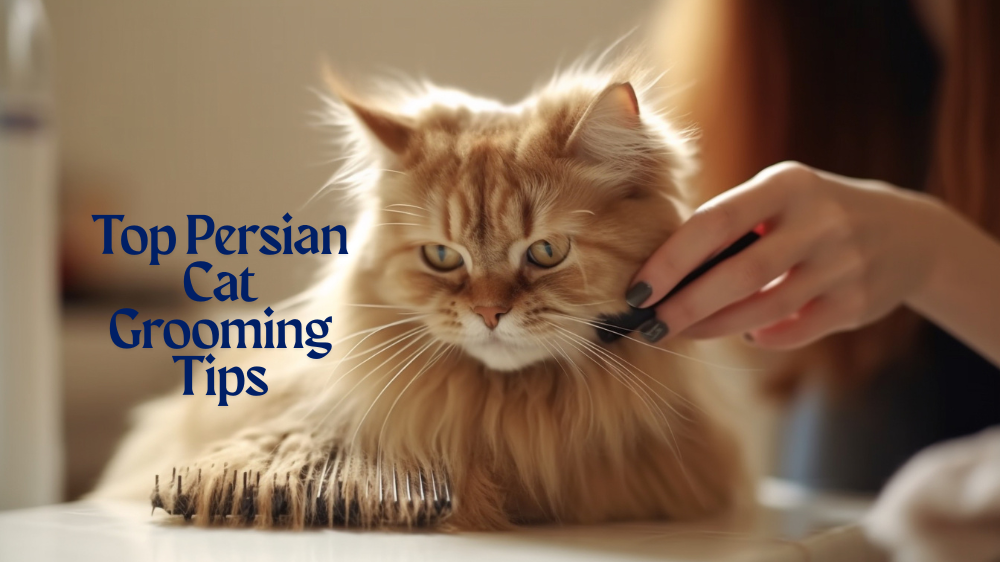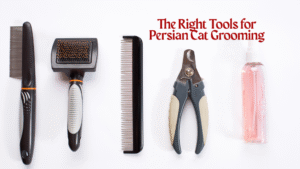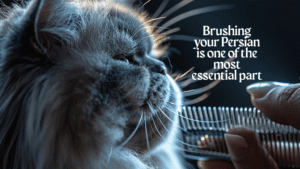“Persian cat grooming” plays an essential role in keeping your Persian as not only good looking but also healthy. Persian cats have long, luscious coats that demand more grooming and maintenance than their short-haired counterparts.
“Persian cat grooming” also involves preventing matting and tangling, the latter of which can cause the cats some pain and skin irritation. Regular grooming also aids in shedding prevention, hairball control and coat health.
Whether you’re a first time owner, or an experienced cat parent, “Persian cat grooming” is key to keeping that beautiful, silky smooth coat the cat is known for.
How To Care For Persian Cats – Everything From Grooming to Nutrition
Knowing the mechanism of “Persian cat grooming” can make you a step ahead in maintaining the radiance and health of your cat’s coat. The thick, long hair of the Persian cat definitely needs care so in this case “Persian cat grooming” is just a little different than just grooming a short haired breed of cat.
Persian cat-style brushing on a daily basis/maintenance is the key to avoiding tangles, mattes, and shedding. By learning these basics, you can give your Persian the best environment possible and maintain a beautiful coat.
The Unique Coat of Persian Cats
“Persian cat grooming” begins with knowing the type of coat they have. Persian cats have dense, lengthy coats that tangle easily, especially under their “armpits” and hind legs. Persian cat fur maintenance is crucial in order to keep their coat in check and avoid getting matted.
Without grooming these mats tug at the skin, creating discomfort. They have a thick undercoat which traps unwanted hairs, so they require regular “Persian cat grooming” to prevent that silky coat from tangling.
How Often Should You Groom Your Persian Cat?
For “Persian cat grooming,” it’s frequency that counts. Whether you’ve got a Persian that’s got matted fur or you’re just trying to maintain a healthy coat, brushing Persian cats should be a daily routine.
This adds an effort to avoid the formation of a bundle and reduce the shedding. The more times you brush your Persian, the easier it will be to keep that beautiful coat looking great.
Other maintenance to their grooming should be regular Persian cat brush and an occasional bath, because with Persian cat bath tips and brushing – you’ll help keep their skin and fur healthy too.
Why Is Regular Grooming Important for Persian Cat Coat Health?
Regular “Persian cat grooming” is about more than just looks — it’s about keeping your cat healthy. Brushing your cat’s hair on a regular basis helps to spread natural oils throughout its coat, which can give your cat a shiny, soft coat.
Daily ginger grooming also minimizes the formation of dead hair and mats, which can cause skin irritation. In addition, grooming helps reduce excessive shedding and helps prevent hairballs to keep her coat healthy and skin comfortable.
Choosing the Right Tools for Persian Cat Grooming
Using the best grooming supplies is essential when you want to groom Persian cats. The proper tools help make grooming easy and painless for you and your cat.And if you are struggling with tangles or shedding, or just want to keep the health of your Persian cat’s coat, as their priority, the right grooming tools can make a world of difference.
Best Brushes for Persian Cats
When it comes to “Persian cat grooming”, you want to use the right brush for your Persian cat since it is important to prevent their coat from matting up. Pin brushes are also perfect for Persian cat brushing because it helps separate hair and prevents it from tangling and mats from forming, without being rough or causing any pain.
Slicker brushes are also good for staying on top of loose hair and keeping tangles at bay. They also promote a healthy Persian coat by spreading the natural oils and encourage the fur to remain shiny. Some combination of these brushes is necessary for any Persian cat grooming plan.
Choosing the Right Brush Based on Fur Type
The best brush for “Persian cat grooming” really depends on your specific cat’s fur type. For Persians with thicker, fuller hair, a slicker brush is recommended for grooming Persian cats. It’s so good at cutting mats and tangles without hurting the fur.
For routine Persian cat brushing, a pin brush with soft, pliable pins will help the softness of the fur but prevent it from becoming too matted. Take into account the texture and length of your Persian’s coat when choosing your grooming tools.
Essential Grooming Tools
Aside from brushes, there are a few other Persian cat grooming tools that you’ll want to have on hand to keep your cat’s coat healthy. Nail clippers are a must-have tool, so you can clip your cat’s nails regularly – letting long nails harm your cat not only to be painful, but it can also lead to accidents.
Ear cleaners are also good to have for “Persian cat grooming” since Persian cats suffer from ear problems as a result of their thick coat. Also, you can use a mild cat shampoo formulated for longhaired breeds to help keep your Persian’s coat clean and soft.
You wouldn’t need to break a sweat with the right grooming equipment to keep your Persian cat as neat and gorgeous as it should be.
Step-by-Step Guide to Grooming Your Persian Cat
In the case of “Persian cat grooming”, you must have a method. Persian cats are famous for their long beautiful coats, but they are high maintenance and need regular attention to keep both their coats and bodies healthy.
But first let’s go through each of the stages of grooming Persian cats to keep them happy, healthy and looking fabulous.
How to Groom a Persian Cat: Brushing Techniques
The right “Persian cat grooming” starts with good brushing. Brushing your Persian is one of the most essential parts of Persian cat care and can help to prevent matting, control shedding and keep the coat in fabulous condition. Here is a step by step walkthrough to grooming Persian cats:
1.Start with the Right Brush:
The beginning of Persian cat brushing is using the right brush. The best brush for Persian cat hair is either a pin brush or a slicker brush, since they penetrate through the thick coat easily. A pin brush is good for detangling the fur, while a slicker brush removes loose hair and mats. Such tools are indispensable Persian cat grooming tools to get the pile smooth and silky.
2.Brush in Small Sections:
Separate the fur of your Persian in sections little by little. Start at the tail and go upward towards the shoulders and always brush same the way the hair grows. Grooming Persian cats takes time, especially areas that experience more tangles, such as the underarms and hindquarters.
3.Detangle and Maintain Coat Health:
If you have detected any tangles you can separate them using a dematting comb (be gentle). Be careful not to tug on the fur, for this can be painful. Frequent Persian cat brushing assists in the natural oils being distributed throughout the cat’s coat, resulting in a rich deep Persian cat coat sheen and health for the Persian cat coat itself.
4.Finish with a Comb:
Comb through your Persian’s coat once you have brushed them. It doesn’t take too long and is an important step to ensure you’re not leaving any loose hairs behind, which can help keep their coat silky and tangle-free.
By implementing Persian cat brushing into your regimen, you will not only prevent mats but also encourage Persian cat fur maintenance and a nice, healthy coat.
Bathing Your Persian Cat Without Stress
Bathing is another important point of Persian cat grooming, and it can be difficult for both you and your Persian cat. But, if you know the right approach, it doesn’t have to be stressful at all. And here’s how to give your Persian a bath the right way:
When to Bathe Your Persian Cat:
How to groom a Persian cat includes the occasional bath, but not all the time. Ideally, Persian coat care in the form of a Persian cat bath should occur no less than every 4-6 weeks. Too much bathing can dry out their skin and ruin their coat. Though, if you notice your Persian’s coat to be way too greasy or dirty then a wash may be in order before that.
How to Bathe Your Persian Cat:
- Prepare the Bathing Area: Fill a shallow tub or sink with lukewarm water. It’s crucial to ensure that the water is sufficiently warm for your Persian as well, so that the warm water will not become a stressor.
- Gentle Shampooing: A high-quality Persian cat shampoo which won’t harm the delicate skin of your pet when water-bathing it is necessary. Use a Persian cat bath tip which will keep the coat soft and clean of its own. Just apply the shampoo into their fur and massage it in well, then rinse.
- Drying Your Persian: Gently towel-dry your Persian after its bath. Here, Persian cat fur conditioning is key. You can even employ the use of a blow dryer on low to cool – just be sure it doesn’t heat up too much and burn their skin or fur.
Bathing Products to Keep the Coat Soft and Shiny:
You will want a Persian cat-specific conditioner to keep their fur soft and shiny after a bath. Both these products are great as they will enable your cat’s coat of fur to maintain its natural oils, an essential element of “Persian cat fur maintenance”.
Maintaining a Healthy Persian Cat Coat Between Grooming Sessions
But beyond that, “Persian cat grooming” also includes all of the things you can do between your grooming appointments to help keep your Persian cat’s coat, eyes, teeth and overall quality of life healthy and happy. These are the same techniques that will keep your Persian’s hair looking clean and beautiful between professional grooming sessions.
How to Prevent Hairballs in Persian Cats
Hairballs can be a big problem in Persian cat care. Long-haired Persian cats are more likely to ingest hair while grooming, and may develop hairballs. Here are some ways to diminish the problem:
Diet for Hairball Prevention:
The diet is the first and foremost prerequisite to the prevention of hairballs. Feed your Persian cat a diet high in fiber. There are special hairball prevention diets, which encourage easier digestion and lower formation of hairballs.
Daily Brushing:
The best way to avoid hairballs is by brushing your Persian cat regularly, lessening those pesky hairballs. You massively reduce the risk of hairballs by pre-empting swallowed loose fur.
Hydration:
Ensure your Persian has unrestricted clean water. Kitten’s digestive system cannot remove hairballs till they are 15 months old. Cats with inadequate water intake will suffer from dehydration. Drinking enough water can help your cat avoid hairballs.
Grooming a Persian cat has more benefits than you might realize. It’s also a great way to help control shedding, which can be a problem for Persian cats. With a few simple tricks you can ‘manage Persian cat hairball and shedding prevention with little effort, and have an easier, more pleasant grooming experience.
Table: Grooming Checklist for Your Persian Cat
| Grooming Task | Recommended Frequency | Tools Needed | Benefits |
| Brushing | Daily | Pin brush, slicker brush | Prevents mats, reduces shedding, promotes shine |
| Bathing | Every 4-6 weeks | Cat shampoo, towel, lukewarm water | Keeps coat clean, softens fur, reduces odors |
| Nail Trimming | Every 2-3 weeks | Nail clippers | Prevents overgrown nails, promotes comfort |
| Ear Cleaning | Weekly | Ear wipes or solution | Prevents infections, removes wax buildup |
| Hairball Prevention (Diet) | Ongoing | High-fiber diet or hairball treats | Reduces hairballs, improves digestion |
How to Deal with Common Grooming Challenges for Persian Cats
They may have gorgeous hair, but “Persian cat grooming” isn’t always a walk in the park. From stubborn mats to ensuring a top condition coat – It takes more than regular brushing to preserve a Persian cat’s beauty. Here’s how to address the most common grooming problems and make sure your Persian remains comfortable and healthy.
Dealing with Matted Fur
One of the most common problems “Persian cat grooming” is matted fur. Persian cats have thick, long fur that is susceptible to matting, and without the proper grooming maintenance, mats can form which may cause pain and in some cases skin irritation.
Why Mats Form:
Mats are generally caused when dead hair falls into the longer hair and gets caught. This tends to be most noticeable in the undercoat, particularly if your Persian’s fur is left unbrushed. As the undercoat of Persian cat is so thick, due to tangle, it will get knots easily, especially around the neck, ears, the back of the legs, which may lead to pain and lesions as a result.
How to Handle Mats:
Prevention is the best way to deal with mats. Regular Persian cat brushing with a slicker brush or pin brush helps eliminate tangles before they progress to mats. For those mats you’ve already got, don’t yank them out, as it can cause both pain and damage to the skin.
Recommended De-Matting Tools and Techniques:
-
- De-matting combs: These combs feature sharp, fine teeth that can gently slice through mats without harming the fur.
- Scissors: Very difficult tangles can be cut with grooming scissors, but be careful. When you are trimming, be careful to only trim the matted fur and to not get too close to the skin (if you do, you might cut your pet and only cause them pain and additional irritation).
Be sure to cut or pick away only tiny portions at a time in a small area at a time to avoid stressing your cat.
With the use of the best Persian cat grooming tools and methods, you can treat mats before they get bad, and maintain your Persian cat’s coat in healthy, mat-free condition.
Maintaining Coat Health and Condition
Regular “Persian Cat Grooming” sessions are only one part of ensuring your Persian Cat is groomed correctly. Your Persian’s coat will remain soft, shiny, and beautiful when you have a good care routine. Here’s how you can care for their coat
How to Ensure Your Persian Cat’s Coat Stays Shiny and Healthy:
A lot of maintenance goes into the health of a Persian cat’s coat to keep it from becoming dry or dull. Keep your Persian well-groomed with the right tools. Brushing your Persian cat once or twice a day using a regular brush is necessary to remove dead hair and distribute natural oils so that the coat stays smooth and shiny.
The Role of Diet and Supplements for Coat Health:
Nutrition While good nutrition is key to keeping a Persian cat’s coat looking wonderful. By providing your Persian with a good quality of food that is rich in protein, Omega-3 fatty acids and essential vitamins that helps ensure healthy skin and fur. Some supplements such as fish oil can also assist in the maintenance of a Persian cat coat health sheen and decrease shedding.
Regular Hydration:
Remember that water is also critical to maintaining the moistness of your Persian’s mane A well-hydrated cat will also have better-looking, shinier fur. Always have fresh water available for your Persian to maintain healthy skin and a healthy cat.
Combined with regular brushing and a good diet and plenty of water, your Persian’s coat will be shiny and healthy.
Conclusion:
Regular “Persian cat grooming” is necessary to keep your Persian cat looking shiny and healthy. Avoiding the recommended practices, in the Persian cat care guide, you can prevent mats, reduce shedding, and keep the coat shiny and fluffy. You just need a twist of regular brushing, a bit of bathing, and a healthy diet and they shall offer you the finest results. Regular grooming will keep your Persian’s coat healthy and they’ll look and feel great.
With a “Persian cat grooming” routine, however, you can contribute to your Persian cat’s overall comfort and wellness and admire that beautiful, silky coat for years to come.
FAQ – Your Persian Cat Grooming Questions Answered
Below are some frequently asked questions about “Persian cat grooming,” along with some answers to help you maintain your Persian’s coat in tip-top shape.
1.How frequently should I groom my Persian?
How often you should give a Persian cat grooming depends on the age of your cat, your cat’s health, how much grooming its coat needs. Most adult Persian cats require daily brushing to prevent their hair from becoming tangled and shiny.
You may need to groom less often for an older cat, one with thinner or smaller coat, but brush daily to control shedding and prevent tangles. Regular “Persian cat brushing” is important to ensure mats do not form and promote “Persian cat fur maintenance”.
2.If my Persian has no interest in grooming?
Most Persian cats are not fans of grooming, but with the proper approach, you can help ensure that it is a pleasant experience for both you and your cat. You will need to be gentle and reward your cat with treats during this introduction.
Try to pair Persian cat grooming with a positive experience by providing treats or playtime as a reward. If your cat is on the more sensitive side, you can consider shortening the length of grooming, or adding new persian cat grooming tools to help them feel more at ease.
3.Do I need to bathe my Persian cat it’s a regular manner?
Bathing is one of the most relevant parts on how to groom a Persian cat, and it does not need to be performed very often. Bathe your Persian cat every 4 to 6 weeks. Bathing too often can remove their fur’s natural oils and cause it to become dry and breakable.
Maintain its soft and shiny coat by way of shampoo and Persian cat bath tips that are specifically suited for long hairs. Frequent bathing contributes to the upkeep of Persian cat coat and the reduction of skin problems.
4.How can I stop my Persian cat from shedding?
Shedding can be a big issue when it comes to Persian cat grooming. Shedding can be minimised thoroughly with regular brushing of the Persian cat. A slicker or pin brush is the best tool for the job.
Make sure your Persian cat is on a well balanced diet to help reduce shedding and to help maintain that beautiful Persian coat. Also, the use of hairball prevention balms and regular grooming will really help reduce the amount of fur that your Persian cat sheds.
5.Is it safe to use human shampoo on my Persian cat?
Human shampoo should never be used on a Persian cat. Human shampoos can throw off the pH balance of your cat’s skin and irritate it. Always use Persian cat shampoo for long-haired breeds so you’ll know it’s gentle and effective. This will keep your cat’s skin and coat healthy and supple.
6.How can I stop my Persian cat suffering from hairballs?
For Persian cat hairball prevention the answer is regular groomings. Routine Persian cat brushing removes this hair before it can be swallowed. Moreover, a high fiber diet will also aid in preventing hairballs by assisting in healthy digestion. And remember to keep your Persian hydrated, perhaps by feeding it hairball prevention treats to help with digestion!




